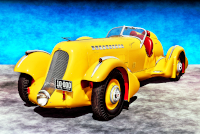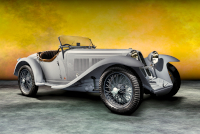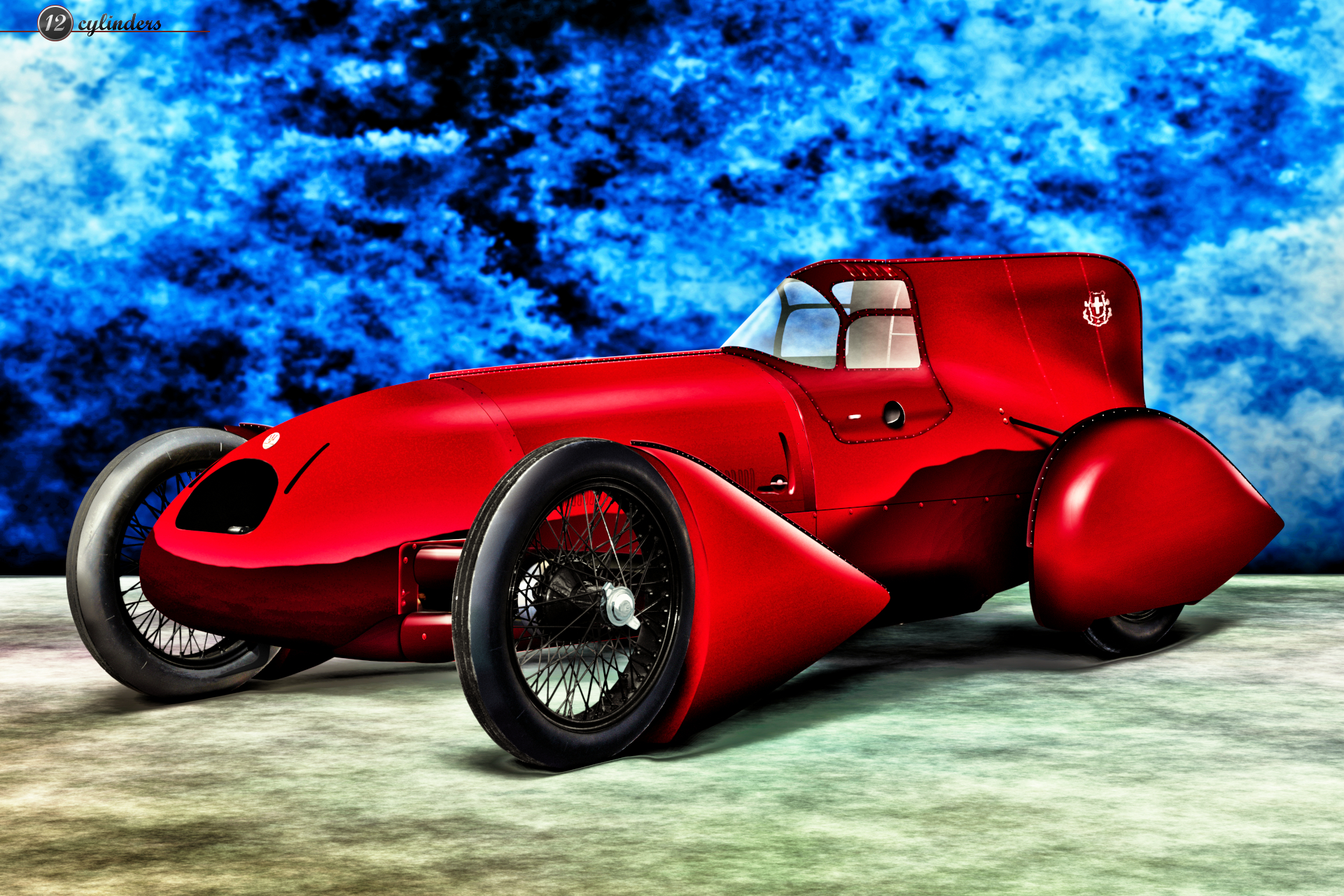Maserati Siluro 4CM 1500 Carenato, Viotti, #1536, 1937
Prologue:
Another lost Maserati that bears illustrating in high-definition, the Siluro 4CM is a difficult car to understand. Sources often suggest this streamlined record car is the same as Giuseppe Furmanik's earlier 4CM #1120, built by Maserati in 1932. But these would seem to be different cars, both of Furmanik's speed-chasing enterprise.
What we see here is the coachwork conceived by Centro Sperimentale Aeronautico di Guidonia and built by Carrozzeria Viotti. Furmanik uses less of it. And in various combinations. For our purposes, it seems plausible that the Siluro 4CM Carenato uses a 6CM 1500 chassis, though its subsequent disappearance prohibits verification.
Here, I want to illustrate the complete concept with the original wire wheels, which also updates the color sketches Massimo Grandi presents in his thorough engineering assessment. The story of Furmanik himself is equally intriguing. So tackling the quagmire of the lost Siluro 4CM Carenato is worth the effort.
- - - - - - - - - -
► Image Source: Nikon D750 (24.3 MP) illustration finished at 28.2 MP
References:
- Cancellieri, Gianni; Dal Monte, Luca; De Agostini, Cesare; Ramaciotti, Lorenzo. (English translation by Neil Davenport and Robert Newman.) "Maserati, A Century of History: The Official Book" Giorgio Nada Editore, Vimodrone, Milano, Italia. 2013, page 271-272
- Crump, Richard; de la Rive Box, Rob. "Maserati Sports, Racing and GT Cars from 1926" Third Edition, G.T. Foulis & Company for Haynes Publishing Group PLC, Somerset, England. 1992, page 50, 80
- Primotipo: "Maserati 4CM Record-Breakers" by Mark Bisset, July 6, 2024
- SpeedHolics: "Giuseppe Furmanik’s Maserati Siluro 4CM Carenato" by Massimo Grandi
Giuseppe Furmanik and the 4CM Record Cars
The child, Joseph Furmanik, who becomes the man, Giuseppe Furmanik, bumps through an odd course in life. He is Polish, born in Switzerland in 1903, and by age eleven lives in Colombier-Fontaine in the Bourgogne region of eastern France. The year is 1914, when in August Germany declares war on France.
According to French historical sources, Joseph and his friends play a 'French and Germans' game outside, shouting, "Long live France!" and "Long live Prussia!" Perhaps because he is of Prussian descent, Joseph plays for the Germans. The children's game disperses, and Joseph returns home. On arrival, he hears a familiar call, "Long live France!" from outside and, playing along with his friends, delivers its refrain, "Long live Prussia!" through an open window. The initial call, however, originated from French officers who later storm the house and arrest Joseph and his father, Jacob.
The French imprison Joseph and his father as political criminals, chained with those whose crimes may or may not have been more earnest, and eventually exile them to Corsica. Jacob will spend five years incarcerated at Corsica, but, under some apparent protest, the French release Joseph to Vienna, where he finds a benefactor. Three years later, in 1919 and with the war concluded, Jacob finds his son in Vienna and the two emigrate to Italy.
As a young man in Italy, Joseph marries into wealth. He takes interests in engineering as a trade and motor racing as an avocation. He changes his name to Giuseppe and becomes a dominant figure in Italian motorsport governance.
At the point where most motoring sources first mention his name, Furmanik has long aligned himself with Benito Mussolini, and prospers in social standing as a result. He becomes president of the Commissione Sportiva Automobilistica Italiana, a motorsport governance organization under l'Automobile Club d'Italia. Furmanik can be seen in period photos wearing a decorated military uniform in his role for the CSAI, which underscores the connection between government and motorsport in pre-War Italy, just as in Germany.
Throughout the classic era, Furmanik modifies a number of Maserati cars for land speed record attempts, beginning with the 4CM 1100. Maserati build two 4CM cars for Giuseppe Furmanik in 1932, chassis #1115 and chassis #1120. The first, #1115 is a monoposto prototype developed at Furmanik's persuasion, but he does not own the car, which Maserati use for works racing.
Chassis #1120 serves land speed record duty from 1934 to 1936. With clever aerodynamic trim by Mario Revelli di Beaumont, the car resembles something of an Italian salt lakes speedster. Furmanik applies his own mechanical tweaks; he increases compression and raises the rev limit to push 140 bhp from the unit, lightens the chassis, and does without front brakes.
These early record-setting runs with #1120 take place on the Autostrada Firenze-Mare (today's A11), and at the Circuito di Pescara, over three separate attempts. The records Furmanik achieves are:
- November 28, 1934, Firenze (1100 cc class): Flying kilometer, 16.17 seconds, average speed 222.635 km/h
- January 8, 1936, Pescara (1100 cc class): Standing start kilometer, 27.38 seconds, average speed 131.483 km/h
- January 8, 1936, Pescara (1100 cc class): Standing start mile, 39.57 seconds, average speed 146.415 km/h
- January 28, 1936, Firenze (1100 cc class): Flying mile, 23.31 seconds, average speed 248.547 km/h
Furmanik passes #1120 to Gino Rovere, who converts the car back into a racing voiturette. His interest then yields to a thoroughly extreme investment in record-breaking. The car shown here is that project.
This streamlined body is the product of il Centro Sperimentale Aeronautico di Guidonia, an engineering test facility Furmanik would have been able to access given his political standing. Some sources mix Mario Revelli's influence into this design, though we cannot confirm that Revelli contributed to anything more than Furmanik's original 4CM 1100 #1120.
In any case, the results—which pertain only to the car depicted here, #1536, and not 4CM #1120 as those above—are as follows:
- June 2-3, 1937, Firenze (1500 cc class): Standing start kilometer, 24.935 seconds, average speed 144.3 km/h
- June 2-3, 1937, Firenze (1500 cc class): Standing start mile, 34.325 seconds, average speed 168.8 km/h
- June 2-3, 1937, Firenze (1500 cc class): Flying kilometer, 15.9 seconds, average speed 238.6 km/h
In his analysis of the Furmanik speed record attempts, Massimo Grandi suggests that Furmanik could not push the motor to peak output at 7,000 rpm, falling short at 6,400 rpm and suffering for power. So he lost the flying mile record to Frank Lockhart's 1500 cc Miller. Furmanik also toyed with the coachwork, running the streamlined 4CM without fairings, and sometimes without wheel discs, which suggests an empirical approach to balance streamlining effect versus weight reduction.
Still, the streamlined car bettered a few records and reinforced the value of aerodynamic testing besides. And as a design exercise, the Siluro 4CM Carenato is extraordinary compared to the modified 4CM 1100 with which Furmanik began. But then its margin of improvement is perhaps less impressive for the investment.
Back to the matter of Furmanik himself, he survives World War II, but owing to his fascist ties his presence fades from the national scene, apart from his financial support for reconstruction.
Only later, through the long spyglass of history, do the French begin to wonder about the boy, Joseph, who brought accidental catastrophe to his family. And the motorsport community begin to wonder about the man, Giuseppe, who broke land speed records. They wonder where the story leads.
At best, we only know that the late Giuseppe Furmanik lives quietly until his end in 1958 or 1959, perhaps a man of little imprint on the post-War era, but whose astounding origins are specific to the tumult of the early 20th century.
Decoding the Siluro 4CM Carenato
What this car is can't be easily defined. The official Maserati history suggests the car is a 4CM chassis identical to that of #1120. And it is almost certain that this latter record car is not #1120, which survives today in the form Gino Rovere configured after he acquired the car from Furmanik.
Mark Bisset suggests this streamlined record car is a 6CM chassis, #1536. His suggestion partly contradicts the official history, but seems more plausible.
Maserati build a decent number of 6CM 1500 chassis from 1936 to 1939—at least 30, which is a tall number for the racing garage. Of these, Crump and de la Rive Box show a gap in chassis numbers, skipping from #1535 to #1537. So the suggestion that #1536 is an uncatalogued 6CM fits their omission.
As to the matter of the chassis being identical to that of #1120, if the car here is a 6CM then the wheelbase would be 2,490 mm to the 4CM's 2,400 mm, and would use independent front suspension as developed on the V8RI. So the chassis would be close, but not identical.
That said, the 6CM 1500 fits a 4-cylinder block of the same capacity, so the discrepancy could be easily forgiven. Furthermore, the front suspension arms on this car resemble the independent unit of the V8RI much more than that of the 4CM 1100. The later 4CM 1500 also uses a visually similar set-up, but records do not show any of these cars sold to Furmanik, and the chassis numbers do not fit the 1530s range Bisset suggests. So by considering the front suspension and order history, it would seem the 6CM theory could be correct.
We therefore follow the 6CM proposal. The date of manufacture aligns with Furmanik's later record attempts. The chassis would accommodate a 1500 cc 4-cylinder. The proportions would look very similar to a 4CM. And the front suspension looks to be a later independent unit.
Motor: 1,496 cc straight 4-cylinder, cast-iron block and head | 69 mm x 100 mm | 6.0:1 compression
Like chassis #1120's tuned 1100 cc motor, #1536 would have used a version of the 1500 cc motor massaged by Furmanik to run higher compression at higher revs.
Valvetrain: DOHC, 2 valves per cylinder
Aspiration: single Weber carburetor, Roots-type supercharger
Power: 140 bhp at 7,000 rpm
Drivetrain: 3-speed non-synchromesh gearbox, rear-wheel drive
Furmanik used only three gears to lighten as many mechanical components as possible.
Front Suspension: independent torsion bars, friction dampers
Rear Suspension: live axle, semi-elliptic leaf springs, friction dampers
Architecture: steel tubular chassis, aluminum coachwork by Viotti of Torino
Wheelbase: 2,490 mm (98.03 inches)
Top Speed: 241.5 km/h (150 mph)
Interesting, the highest recorded speed for this streamlined record car is 238.6 km/h (148.25 mph), recorded as an average over the flying kilometer. Accounting for about 2 mph variation, 150 mph is a reliable top speed estimate.
But this achievement is less than the maximum recorded speed of Furmanik's 4CM 1100, which averaged 248.547 (154.43 mph) over the flying mile. Likely, il Centro Sperimentale Aeronautico di Guidonia would have provided a theoretical top speed in developing this streamlined body. But Furmanik did not reach that limit by any recorded account owing to mechanical difficulties and some hesitation over how to best use these fairings. So we cannot confirm that the Siluro 4CM Carenato with a 1500 cc motor is faster than the original 4CM 1100 at the top end because the car never reached its potential.
Etymology:
I take guidance from Massimo Grandi to construct this model designation. The '4CM 1500' nomenclature identifies the motor in this case, a 4-cylinder of 1500 cc capacity, whereas some uncertainty persists about the chassis. In Italian, 'siluro' is 'torpedo,' and the term 'carenato' means 'faired,' as in the use of fairings to streamline the wheels and outboard components.
Carrozzeria Viotti of Torino produce the coachwork, designed by Centro Sperimentale Aeronautico di Guidonia. And we suspect chassis #1536 may be correct if indeed this car uses a 6CM tubular chassis.
Figures:
Mark Bisset suggests the car is a combination of an un-catalogued 6CM, likely a 6CM 1500 built around 1936, with a 4-cylinder 1500 cc motor. This streamlined car was unique, and it no longer exists.
The Style of Speed: Furmanik's Siluro 4CM Carenato
Part of my interest in illustrating lost designs is discovering what they look like as they come to life. Proportion is critical, without which the details are meaningless.
In this case, I elected to construct the torpedo-bodied 4CM as it appears in publicity photographs prior to Furmanik's speed record attempts in 1937. This configuration uses the original wire wheels with narrow tyres and full fairings front and rear. Period photographs of Furmanik's actual use of the car show different combinations of wire wheels and wheel discs shod with different tyres, with the fairings often removed. A notable anecdote, David Abbott Jenkins uses a similar approach with the Duesenberg Mormon Meteor, which he did not run with the wheel fairings designed by J. Herbert Newport.
The fuselage is cigar-shaped and bulky, perhaps inelegantly bullish through the nose, with a pizza-oven duct for the motor. I'm not certain how the two narrow slits either side of the duct function, maybe to reduce turbulence as air rushes inside the nose.
The bonnet is broad, with louvres positioned low along the flank. The canopy is wholly aeronautical in design and opens forward from hinges at the lower front edge.
Those wheel fairings that disappear after the car's publicity photos follow a teardrop form. I might have drawn them a tad too large and a bit tight to the wheelsets, but then no photographs of this configuration exist from a quarter perspective where these elements would appear foreshortened, whereas in profile the car appears elongated. So my interpretation depicts a different pose from an original perspective.
Perspective distorts the broad tail fin as well, which rises gently from the canopy out over the tail. I tried to retain this shape and not allow the perspective to curve the tail, just to indicate the true profile. And in perspective this element appears much shorter.
Most interesting, each aerodynamic element uses a riveted ridge—the bonnet, canopy, fairings, and tail all formed in clamshell construction. This method is wholly of the classic era, a rudimentary method of crafting narrow, fluid forms.
Otherwise, I tried to count the rivets wherever possible and craft the suspension, seams, and various paraphernalia as depicted in grainy monochrome.
In the end, the Maserati shares aerodynamic ideology with the Mormon Meteor, but on a small scale. Without its fairings, the Siluro 4CM looks funky. But in carenato configuration, the shape is rewarding to investigate for its aeronautical influence. The concept is a four-wheeled aircraft with diminished wings, married to Paul Jaray's aerodynamic theory.
In his engineering assessment of the Siluro 4CM Carenato, Massimo Grandi suggests that Centro Sperimentale Aeronautico di Guidonia envisioned a fully faired design with more curvature in the fairings as opposed to the teardrop forms Viotti crafted. His sketches also play with the tail form, which in reality is not so creased but gently folds from the vertical fin down over the rear fuselage. Whether the original design meant to place a sharper seam departing from the lower edge of the canopy, or even from the upper edge, the actual result uses sheet metal like paper held together with riveted seams on thin internal spines. Again, this method is aeronautical.
Lastly, I will not speculate on the origin of the crest on the tail fin, which no period image reproduces with fidelity.
And this last note adds yet another unknown to the car's story. At the very least, I hope the my suppositions seem reasonable, and the visual components thought-provoking. I enjoyed the trouble, and only hope I have not stirred up too much more.
Last Updated: Mar 26, 2025
Editor's Picks


© Copyright 2008-2025, 12cylinders.com | images and text by Dominic Anthony

